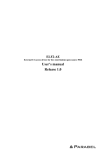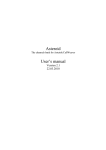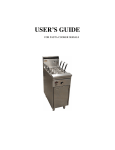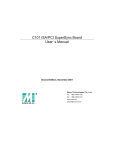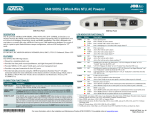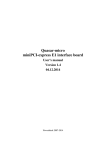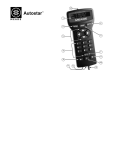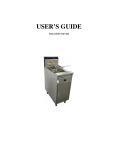Download ELF2-MEEV User`s manual
Transcript
ELF2-MEEV E1/V.35 multiplexer User’s manual Software release 1.11 ELF2-MEEV User’s manual Attention! It is not recommended to use the multiplexer on physical lines without lightning protectors. 2 ELF2-MEEV User’s manual © PARABEL, ltd ALL RIGHTS RESERVED ELF2-MEEV MULTIPLEXER USER’S MANUAL RELEASE 1.11, MAY 2005 PARABEL LIMITED P.O. BOX 126 NOVOSIBIRSK-90 RUSSIAN FEDERATION Web: eng.parabel.inc.ru Email: [email protected] Phone: +7-3832-138707 Fax: +7-9139139603 3 ELF2-MEEV User’s manual CONTENTS FIGURES.......................................................................................................................................................5 TABLES ........................................................................................................................................................5 1. Introduction................................................................................................................................................6 2. Specifications.............................................................................................................................................8 2.1. General................................................................................................................................................8 2.2. E1a, E1b ports parameters ..................................................................................................................8 2.3. V.35 port parameters ..........................................................................................................................8 2.4. Console port parameters (RS232).......................................................................................................8 3. Installation of the multiplexer....................................................................................................................9 3.1. Front Panel Controls, Connectors, and Indicators ..............................................................................9 3.2. Sockets description ...........................................................................................................................10 4. Multiplexer configuration........................................................................................................................13 4.1. Console attaching..............................................................................................................................13 4.2. The main configuration menu...........................................................................................................13 4.3. General settings ................................................................................................................................14 4.4. E1a port configuration ......................................................................................................................14 4.5. E1b port configuration......................................................................................................................15 4.6. V.35 port configuration ....................................................................................................................15 4.7. Testing modes...................................................................................................................................15 5. Monitoring the multiplexer ports.............................................................................................................17 6. Functional description .............................................................................................................................18 6.1. The interface converter mode ...........................................................................................................18 6.2. Drop-insert mode ..............................................................................................................................19 6.3. CRC4 handling .................................................................................................................................20 6.4. CAS signaling...................................................................................................................................20 6.5. DTE emulation mode of V.35 port ...................................................................................................20 7. Upgrading firmware.................................................................................................................................22 8. Multiplexer delivery ................................................................................................................................22 9. Package ....................................................................................................................................................22 Appendix A. Applications ...........................................................................................................................23 4 ELF2-MEEV User’s manual FIGURES Figure 1. ELF2 block schematics ..................................................................................................................6 Figure 2. Drop-insert mode............................................................................................................................7 Figure 3. Front panel......................................................................................................................................9 Figure 4. Rear panel.......................................................................................................................................9 Figure 5. The main menu.............................................................................................................................13 Figure 6. Lloop mode ..................................................................................................................................15 Figure 7. Rloop mode ..................................................................................................................................16 Figure 8. E1 slave synchronization..............................................................................................................18 Figure 9. E1 master synchronization ...........................................................................................................18 Figure 10. Drop-insert switching.................................................................................................................19 Figure 11. Drop-insert mode........................................................................................................................19 Figure 12. DTE mode example....................................................................................................................20 Figure 13. Connecting two LAN over SDH ................................................................................................23 Figure 14. Using drop-insert mode..............................................................................................................24 Figure 15. “Last mile” with DTE mode and external DSL modem ............................................................25 TABLES Table 1. Socket E1A ....................................................................................................................................10 Table 2. Socket E1B ....................................................................................................................................10 Table 3. Socket V.35 (DTE mode) ..............................................................................................................11 Table 4. Socket V.35 (DCE mode)..............................................................................................................12 Table 5. Console socket...............................................................................................................................12 Table 6. Status of E1 ports...........................................................................................................................17 Table 7. V.35 port status..............................................................................................................................17 5 ELF2-MEEV User’s manual 1. Introduction Multiplexer ELF2-MEEV can be used on the primary E1 channels as TDM multiplexer, interface converter, or drop-insert multiplexer. As distinct from competitor products, the ELF2 multiplexer has the following advantages: • Port V.35 has mode of DTE emulation, so other multiplexers or modems can be attached to V.35 port without risk of clock slip. The embedded elastic buffer compensates difference in data rates on V.35 port. The second E1 port can be used in drop-insert configurations and daisy chain connections of the ELF multiplexers The extended capabilities of CAS signalization in timeslot 16 • • • The multiplexer ELF2-MEEV has the following physical ports: • Digital port V.35 with DTE or DCE modes • Port E1A framed/unframed/drop-insert • Port E1B framed/unframed/drop-insert • Console port (RS232 interface) The block schematics of the multiplexer is presented on Figure 1. Port E1A Framer A TDM switch Tx slip buffer Deframer A Relay Rx slip buffer Port V.35 Control & status Port E1B Deframer B CPU Figure 1. ELF2 block schematics 6 Console RS232 ELF2-MEEV User’s manual The multiplexer supports two working modes: interface converter mode and drop-insert mode. In the interface converter mode port V.35 and port E1A are used for data transmission. Port E1B is not used. Input signal of the E1A port connected to the de-framer A, where it is processed according to ITU recommendations G.703 и G.704. Extracted in the de-framer timeslots are sent to the receiver slip buffer. From the slip buffer data is transmitted to digital port V.35. In the other direction, data from V.35 port is pushed to the transmitter slip buffer. From the slip buffer data is sent to TDM switch, then to the framer of channel A. The framer A forms G.704 cycle structure. Port E1A can function in unframed or framed modes. In the first case whole E1 stream is used for data transmission, including timeslots 0 and 16. This results to data rate 2048 Kbit/s. In the second case user can chose timeslots for data transmission. The chosen timeslots form united data channel with data rate Nx64 Kbit/s, where N=1..30. Timeslot 0 is used for G.704 synchronization. In the drop-insert mode port V.35 and port E1A are used for data transmission as before, but additionally, port E1B is used for non-data timeslots routing. Framed E1 mode should be set for both E1 ports. Presence of the second E1B port enables connections like shown on the Figure 2. The multiplexer is connected between PBX and central office equipment. voice voice + data E1B E1A PBX ELF2-MEEV Figure 2. Drop-insert mode In the output stream E1A non-data timeslots will be filled by corresponded timeslots from the input stream E1B. Data timeslots will be extracted by multiplexer from the input stream E1A. Non-data timeslots from the input stream E1A will be routed to the output stream E1B. Note, that E1A and E1B ports are not symmetrical – data received and transmitted only through port E1A. Port E1B is used only for voice timeslots. Port V.35 can be set to DTE or DCE modes, independently of multiplexer mode. In the DCE mode port V.35 forms signals of synchronization for an external device. In DTE mode port V.35 receive synchronization signals from an external device. Relay is intended for direct switching E1A and E1B ports in case of power fail. If relay is turned off, the E1A receiver is connected to the E1B transmitter, the E1B receiver is connected to the E1A transmitter. So, in the drop-insert mode E1 line will function even without multiplexer power. In the interface converter mode relay can isolate E1 port from line. 7 ELF2-MEEV User’s manual 2. Specifications 2.1. General Parameter dimensions weight (without power source) power consumption ambient temperature storage temperature humidity power voltage (on DC socket) Value 140x110x35 mm 0.35 kg 5w от +5°С до +45°С от -40°С до +70°С 80% or less 15V +- 20% 2.2. E1a, E1b ports parameters Parameter socket type line type impulse voltage data rate coding signal attenuation, (E1a) signal attenuation, (E1b) standarts impulse form jitter frame structure Value RJ45, 8 pins symmetrical twisted pair, 120 Ohm 3 V +- 10% 2048 kbit/s +- 50 ppm AMI/HDB3 -40 дб -6 дб ITU G.703, G.704, G.706, G.732, G.823 rec. G.703 rec. G.823 rec. G.704 2.3. V.35 port parameters Parameter socket type mode data rate, kbit/s electrical parameters of signals 105-107, 109 electrical parameters of signals 103, 104, 113-115 coding Value 26 pin DB type synchronous Nx64 rec. ITU V.28 rec. ITU V.35 NRZ 2.4. Console port parameters (RS232) Parameters mode data rate, kbit/s flow control electrical parameters of signals Value asynchronous, 8N1 38400 no rec. ITU V.28 8 ELF2-MEEV User’s manual 3. Installation of the multiplexer 3.1. Front Panel Controls, Connectors, and Indicators There is following controls on the front panel:: • Reset button • Power led • Ethernet 100 Mbit led * • Ethernet2 link led* • Ethernet link led * • E1 led, port a (E1-a) • E1 led, port b (E1-b) • E3 led * • Console socket RJ-11 Figure 3. Front panel There is following sockets on rear panel: • Twisted pair Ethernet socket RJ-45 * • Twisted pair Ethernet socket RJ-45, channel 2 * • Port V.35 socket (26-contacts, DB type) • E1A socket RJ-45 • E1B socket RJ-45 • DC input socket Figure 4. Rear panel * is not used in this multiplexer model 9 ELF2-MEEV User’s manual 3.2. Sockets description Contact 1 2 3 4 5 6 7 8 Net RX+ RXTX+ TX+ GND GND Table 1. Socket E1A Contact 1 2 3 4 5 6 7 8 Net RX+ RXTX+ TX+ GND GND Table 2. Socket E1B 10 ELF2-MEEV User’s manual Contact 1 2 3 4 5 6 7 8 9 10 11 12 13 14 15 16 17 18 19 20 21 22 23 24 25 26 Net GND Direction RTS CTS DTR GND CD GND RxCa RxCb TxCa TxCb RxDb RxDa GND output input output TxDa TxDb input input input input input input input output output Table 3. Socket V.35 (DTE mode) Note: IC-V35-DTE cable should be used in DTE mode 11 ELF2-MEEV User’s manual Contact 1 2 3 4 5 6 7 8 9 10 11 12 13 14 15 16 17 18 19 20 21 22 23 24 25 26 Net GND Direction CTS RTS CD GND DTR GND output input output TxCa TxCb TxDb TxDa GND input input input input RxDa RxDb RxCa RxCb TxCa TxCb output output output output output output input Table 4. Socket V.35 (DCE mode) Note: IC-V35-DCE cable should be used in DCE mode Contact 1 2 3 4 5 6 Net RXD TXD GND GND Direction input output Table 5. Console socket 12 ELF2-MEEV User’s manual 4. Multiplexer configuration 4.1. Console attaching The console port is connected to the serial port of PC by adapter cable RJ-11 ÅÆ DB-9. Multiplexer is controlled by terminal program with parameters: 38400, 8b, 1s, np, flow control=off (use Teraterm, for example). 4.2. The main configuration menu After power on (or reset) the multiplexer prints main menu on the console and waits input from user. The multiplexer is configured by modification of parameters in hierarchical menus. After configuration is finished, settings can be saved in the flash memory. Screen is divided to two parts. There is the following information in the upper screen part: • Software release number • Firmware release number • The main configuration settings and line status The following menu is resided in the lower screen part (see Figure 5): ELF2-MEEV monitor, v1.13 08/04/2005, Updates: http://parabel.inc.ru/ Firmware: ELF2-MEEV (2*E1, V.35){0x0}, Revision: 0x2 E1/A is LongHaul, E1/B is ShortHaul, Drop-Insert=Off, Swap=Off, DTE=Off E1/A Cfg: Framing=On , MultiFraming=On , Line code=HDB3, Clock=Internal E1/A status: LOS=On , LOF=On , LOM=On , LOC=Off, RAIS=Off, FrErr=0/0 E1/B status: LOS=On , LOF=On , LOM=On , LOC=Off, RAIS=Off, FrErr=0/0 V35 status: DTR(CD)=Off, RTS(CTS)=Off 1 3 5 7 9 1 3 5 7 9 1 3 5 7 9 1 Timeslots E1/A: ###############.###########.... 1. Configuration >> 3. Test >> 9. Reset Figure 5. The main menu To choose a submenu, press keys 1-9. To abandon submenu, press key 0. Other keys are ignored. 13 ELF2-MEEV User’s manual 4.3. General settings Configuration/Common/Relay – turn on or turn off the bypass relay. When turned off, the output E1a signal is connected to the input E1b signal, and the input E1a signal is connected to the output E1b signal. When turned on, E1a and E1b signals are connected to the ports of the multiplexer. Configuration/Common/Drop-insert – turn on or turn off drop-insert mode. If drop-insert mode is off, the multiplexer is function like interface converter between ports E1a and V.35, port E1b is not used. If drop-insert mode is on, data stream from V.35 port is received and transmitted through the E1a port. Data timeslots are defined in the E1a port submenu. Non-data timeslots from the E1a port are routed to the E1b port. Configuration/Common/Swap A/B – swap E1a and E1b sockets. In the state “On” ports E1a and E1b are exchanged, that is equivalent cable swapping in E1a and E1b sockets. In this case data transmission goes through port E1b. 4.4. E1a port configuration Configuration/E1/Framing – turn on framed mode of the E1a port. In the framed mode bit stream is formatted according the recommendation ITU G.704. Port V.35 data is incapsulated to the defined E1 timeslots with data rate Nx64 kbit/s (N is number of used timeslots). Timeslot 0 is used for synchronization anyway. In the unframed mode V.35 port data is incapsulated to the unformatted G.703 stream with fixed data rate 2048 kbit/s. Configuration/E1/MultiFraming – turn on or turn off CAS multiframe in the timeslot 16. The multiframe generation is used only for compatibility with some telephone equipment. This mode is not impact on the data transmission capabilities of the multiplexer. Configuration/E1/Line code – line code settings (AMI or HDB3). Configuration/E1/Clock source – line synchronization setting. Line – synchronize on received E1a signal (slave). Internal – synchronize on internal clock source (master). Configuration/E1/Timeslots – define timeslots used for data transmission (data timeslots are marked by # symbol). Configuration/E1/ts16 ABCD – hex digit 0..f, which is define ABCD bits in CAS multiframe. ABCD bits, defined here, are inserted in the timeslot 16 if it is not used for data transmission. Configuration/E1/CRC4 – turn on or turn off CRC4 generation in the transmit direction. 14 ELF2-MEEV User’s manual 4.5. E1b port configuration E1b port is used only in drop-insert mode. There are no special configuration options for this port. While enabled, E1b works in the framed mode and synchronized to line (slave). Line coding (AMI/HDB3) and timeslots settings for port E1b are used the same as for port E1a. 4.6. V.35 port configuration Configuration/V35/DTE – turn on or turn off DTE mode of the V.35 port. In DTE mode data synchronization signals (TxC, RxC) are inputs and they are formed by external equipment. DTE mode can be used for connecting modem or other multiplexer to V.35 port. If DTE mode is turned off, synchronization signals TxC and RxC are outputs and they are formed by the multiplexer. Configuration/V35/Inverse clock – inverse data synchronization signal RxC (DCE mode only). This option is used for attaching non-standard equipment. Usually this option is off. Configuration/V35/Inverse data – inverse data signals TxD, RxD. This option is used for attaching nonstandard equipment. Usually this option is off. 4.7. Testing modes Test/E1/Lloop – turn on internal loopback on the corresponding E1 port (Figure 6Figure 6). E1 Tx Rx Figure 6. Lloop mode 15 ELF2-MEEV User’s manual Test/E1/Rloop – turn on remote loopback on the corresponding E1 port (Figure 7). E1 Tx Rx Figure 7. Rloop mode Test/E1/TAOS – send all ones (alarm signal) on E1 port Test/E1/Freq – measure and print E1 carrier frequency (relative to internal oscillator). 16 ELF2-MEEV User’s manual 5. Monitoring the multiplexer ports Status of the E1 port is displayed in the E1 status string in the main menu heading. The status field legend is shown in Table 6. Field LOS Meaning Lost Of Signal LOF Lost Of Frame LOM Lost Of Multiframe LOC Lost Of CRC4 FrErr Frame Errors Values On Off On Off On Off On Off XX/YYYY Comment No E1 signal carrier E1 signal present, no alarm No G.704 frame detected G.704 frame present CAS multiframe absent CAS multiframe present CRC4 frame absent CRC4 frame present XX – 8 bit counter of frame errors YYYY – 16 bit counter of CRC4 errors Table 6. Status of E1 ports Notes: 1. In the unframed mode LOF, LOM, LOC is not errors 2. To refresh the status press space bar on keyboard 3. To reset error counters choose Test/E1_A/Freq menu of the corresponding E1 port Status if the V.35 port is displayed in the V.35 status in the main menu heading. The status field legend is shown in Table 7. Field DTR(CD) RTS(CTS) Value On Off On Off Comment DTR signal (CD in DTE mode) is active DTR signal (CD in DTE mode) is not active RTS signal (CTS in DTE mode) is active Сигнал RTS (CTS in DTE mode) is not active Table 7. V.35 port status 17 ELF2-MEEV User’s manual 6. Functional description 6.1. The interface converter mode If Configuration/Common/Drop-insert is off, multiplexer works in the interface converter mode between E1 and V.35 port. In this mode data from V.35 port is incapsulated to E1a stream. Data streams in V.35 port and E1a port are considered as synchronous bit streams. Bit order in the V.35 stream is corresponds to the E1a stream bit order. E1b port is not used. In the converter mode E1a port can be set to unframed mode (Configuration/E1/Framing: off) with data rate 2048 kbit/s. In framed mode (Configuration/E1/Framing: on) data rate is Nx64 kbit/s, where N – number of data timeslots. In the converter mode multiplexer is terminating E1 equipment with internal synchronization (E1 master) or data line synchronization (E1 slave). ELF2 E1A V.35 RxC TxC Figure 8. E1 slave synchronization ELF2 E1A V.35 RxC TxC Figure 9. E1 master synchronization 18 ELF2-MEEV User’s manual 6.2. Drop-insert mode If Configuration/Common/Drop-insert is on, multiplexer works in drop-insert mode. In this case both E1 port are used. Timeslots switching scheme is shown on the Figure 10. E1a RX 1 2 3 4 5 6 ● ● 31 FIFO E1b RX 1 2 V.35 3 4 5 1 2 3 4 5 6 ● ● 31 E1b TX 2 3 4 5 6 ● ● 31 E1a TX V.35 6 ● ● 31 1 FIFO Figure 10. Drop-insert switching E1a and E1b ports are set to the drop-insert mode. Timeslots 2,3,4 are used for data transmission in this example. In the «E1a -> E1b» direction E1 stream is passed without changes. Data timeslots are extracted from E1 stream and pushed to the V.35 port. In the «E1b -> E1a» direction timeslots 2,3,4, coming from E1b port are ignored. Multiplexer inserts V.35 data in their place. Other timeslots are passed without changes. Synchronization scheme in the drop-insert mode is shown on Figure 11. ELF2 E1A V.35 RxC TxC E1B Figure 11. Drop-insert mode 19 ELF2-MEEV User’s manual 6.3. CRC4 handling On receive, CRC4 is checked in both E1a and E1b streams, independently of port mode. Result of CRC4 comparing is shown in the port status field (LOC). Invalid CRC4 in the input E1 stream is not affects frame synchronization. On transmit, CRC4 is calculated for E1a port if corresponding mode is set (Configuration/E1/CRC4: on). For the E1b port CRC4 is not calculated as E1b output stream is equivalent to the input E1a stream. On this reason CRC4 on E1b output is calculated by equipment, attached to the E1a input. 6.4. CAS signaling Multiplexer is able to form CAS super-frame in the timeslot 16 with fixed ABCD bits. CAS signalization is used by some telephone protocols, like R2. For correct work of telephone switches and PBX, attached to the common E1 channel with multiplexer, data timeslots must be accompanied by the neutral state code in the timeslot 16. The neutral state code should correspond to the given telephone protocol. To turn on CAS super-frame, set Configuration/E1/MultiFraming menu to state on. ABCD bits code is defined in the Configuration/E1/ts16 ABCD menu. In the interface converter mode ABCD bits are formed in timeslot 16 for channels 1-15, 17-31. In the drop-insert mode ABCD bits are formed only for data channels. For other channels ABCD bits are passed without changes, i.e. they are formed by equipment, attached to the E1b port. Anyway CAS signalization is formed by the multiplexer only if timeslot 16 is not used for data transmission. In opposite case CAS super-frame and ABCD bits are absent in E1 framing. CAS super-frame and ABCD bits are not used on the receive side. In the drop-insert mode CAS signaling is passed from the E1a port to E1b port transparently. If multiplexer is set to the drop-insert mode and telephone equipment use common channel signaling, CAS super-frame must be turned off (Configuration/E1/MultiFraming:off). 6.5. DTE emulation mode of V.35 port DTE emulation mode permits connecting DCE devices to the V.35 port of the multiplexer, for example - modems, multiplexers, TDM switches. The signal scheme of external modem attaching is shown on the Figure 12. Synchronization signals TXC and RXC of the V.35 port are formed by modem and connected to ELF2 inputs. E1 port synchronization is locked to the receive E1 stream. So, multiplexer is synchronized by two independent sources – modem and E1 line. V.35 ELF2 data E1 E1 framer сlk1 data сlk2 FIFO 256 bits Flag Drop/insert Flag Drop/insert FIFO 256 бит rxd rxc DCE device (modem) 128 Kbit/s txd txc Figure 12. DTE mode example Multiplexer will works correctly if data rate in the both ports will be equivalent. On this reason E1 port in this example must use two timeslots for data transmission (128 kbis/s). Note, that data from E1 framer is pushed to the FIFO not evenly in time, but in 16 bit packages with 125 us period and 2048 kbit/s rate. 20 ELF2-MEEV User’s manual FIFO smooth data stream from the E1 framer. FIFO length is 256 bits, that guarantee correct FIFO behavior with any timeslots combination. FIFO is also participates in bit rate alignment. Bit rate alignment mechanism is based on the HDLC flags manipulation. It is supposed, that data transmitted on the E1 channel is organized to HDLC frames. Most of the modern data link protocols are based on HDLC – for example, PPP, FR, Cisco HDLC. Start and end of the HDLC frame are marked by flag – 0x7E octet. The pause between packets is consist of flags also. Except marking frame edge, flags are not transfer useful information and can be deleted or inserted without doubt. Multiplexer deletes flags if FIFO is full on 75% of length or more. Flag deletion is stopped when FIFO is full on 50%. Multiplexer inserts flags if FIFO is empty on 25% of length or less. Flag insertion is stopped when FIFO is full on 50%. Bit rate alignment is correct in case, when synchronization frequencies on E1 and V.35 ports are differed not more then value: dF = NF/(MTU + 1), where MTU – maximum packet length (octets) NF – number of flags between packets, except stop flag MTU and NF are defined by router, connected to data channel. Wide used values are MTU=1500 and NF=1. In this case dF=666 ppm, that is well less then typical frequency deviation in the telecom equipment (100 ppm). 21 ELF2-MEEV User’s manual 7. Upgrading firmware For upgrading the multiplexer firmware do the following: 1. Download the multiplexer firmware 2. Connect console cable and reset multiplexer 3. Program firmware by command flashrs232 -i /dev/ttyS0 -w -f elf.bin (where elf.bin - firmware file). This command programs firmware through PC com1. 4. Check firmware release. String «Firmware: ELF2-MEEV (2*E1, V.35){0x0}, Revision: XXX» must present in the menu heading. 5. Multiplexer is ready for work. 8. Multiplexer delivery Multiplexer is shipped with the following accessories: • Multiplexer – 1 • Console cable (RJ11-DB9) – 1 • CD disk with documentation – 1 The following accessories can be shipped separately: • Power source AC 220V • Power source DC 36..72В • V.35 cable IC-V35-DTE • V.35 cable IC-V35-DCE 9. Package Multiplexer is packaged to the carton box with dimensions 26x21x6.5 cm. 22 ELF2-MEEV User’s manual Appendix A. Applications Router V.35 ELF E1 SDH/SONET E1 ELF V.35 Router Figure 13. Connecting two LAN over SDH 23 ELF2-MEEV User’s manual PBX PBX E1B E1A E1A E1B ELF ELF V.35 V.35 Router Router Figure 14. Using drop-insert mode 24 ELF2-MEEV User’s manual E1 ELF2 V.35 (DTE) Modem DSL DSL line Nx64 kbit/s Modem DSL Router V.35 Figure 15. “Last mile” with DTE mode and external DSL modem 25


























